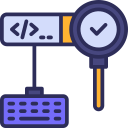Real-Time Audit Data Insights through Coding
Harnessing the full potential of audit data has become essential in today’s digital era, where the volume and complexity of information demands more than traditional analytics. By leveraging coding and automation, organizations can unlock real-time insights, allowing auditors and stakeholders to make faster and more informed decisions. This approach not only streamlines audit processes but also enhances transparency, accuracy, and value, transforming how audits are conducted and interpreted.


Automation as the Catalyst
Automation scripts, built using languages such as Python or R, serve as the backbone of real-time audit data insights. These scripts can continuously ingest data from transactional systems, verify integrity, and execute predefined analytic procedures without manual intervention. Not only does this reduce human error and bias, but it also means auditors spend less time on repetitive tasks and more on interpreting insights. With these time savings, audit teams are positioned to provide higher-value recommendations and focus on complex investigative work that truly benefits the organization.

Continuous Monitoring Over Traditional Sampling
Traditional audits rely heavily on sampling, which, while efficient, risks missing anomalies present outside of the sample set. Real-time coding solutions allow for continuous monitoring of all transactions, keeping an ever-watchful eye on organizational data streams. With this approach, every financial event is scrutinized against set parameters, flags are raised instantly for anything out of the ordinary, and control frameworks are strengthened by immediate feedback loops. The change from after-the-fact review to ongoing surveillance means that risks are mitigated proactively, reducing the likelihood and impact of errors or fraud.
Coding Techniques for Enhanced Audit Reliability
Data Cleansing and Standardization
Data quality is foundational to any audit. Coding facilitates rigorous data cleansing and standardization procedures, ensuring that incoming information from disparate sources is coherent and ready for analysis. Automated scripts can identify duplicate entries, fill missing values, and normalize inconsistent formats, drastically reducing noise and errors in the data. This careful preprocessing not only sharpens subsequent analytics but also simplifies compliance with regulatory standards regarding data integrity. The improved accuracy in audit results increases confidence among stakeholders and supports more defensible audit opinions.
Advanced Pattern Recognition
Through the implementation of advanced algorithms in coding, auditors can detect patterns and anomalies that would be nearly impossible to spot manually. By developing customized machine learning routines or statistical tests, coders can flag unusual transactions, emerging risks, and compliance violations in real time. Not only does this approach accelerate the identification of significant trends, but it also reduces the risk of oversight—a critical consideration in modern audit environments. These tools transform the scope of what is achievable in audit analytics, pushing audits into a new phase of predictive and preventive action.
Repeatable and Transparent Methodologies
One significant advantage of coding is the ease with which audit procedures can be documented, repeated, and audited themselves. Every script, function, and query can be logged, version-controlled, and reviewed for compliance, enabling both transparency and continuous improvement. This repeatability means audits become more consistent across periods and teams, minimizing subjective discrepancies. Furthermore, when procedures change because of new guidance or organizational needs, these updates can be deployed swiftly through code, maintaining alignment with best practices and regulatory expectations.

Integrating Audit Data Streams for Unified Analysis
Acquiring data in real time from multiple systems poses unique challenges, from differing data formats to varying levels of accessibility. With coding, auditors can develop connectors and APIs that automatically pull data from ERP systems, databases, cloud services, and transactional logs as soon as it is available. By automating this acquisition process, the risk of outdated or incomplete information is dramatically reduced, enabling auditors to base their conclusions on current events rather than historical snapshots. This ensures audit findings are relevant and timely, elevating their strategic value.
